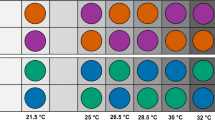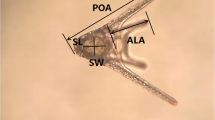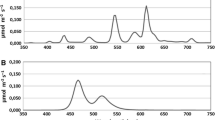Abstract
This study compared the synergistic effects of elevated pCO2 and temperature on the early life history stages of two ecologically and economically important oysters: the Sydney rock oyster, Saccostrea glomerata and the Pacific oyster, Crassostrea gigas. Gametes, embryos, larvae and spat were exposed to four pCO2 (375, 600, 750, 1,000 µatm) and four temperature (18, 22, 26, 30°C) levels. At elevated pCO2 and suboptimal temperatures, there was a reduction in the fertilization success of gametes, a reduction in the development of embryos and size of larvae and spat and an increase in abnormal morphology of larvae. These effects varied between species and fertilization treatments with S. glomerata having greater sensitivity than C. gigas. In the absence of adaptation, C. gigas may become the more dominant species along the south-eastern coast of Australia, recruiting into estuaries currently dominated by the native S. glomerata.







Similar content being viewed by others
References
Anger K (1987) The DO threshold: a critical point in the larval development of decapod crustaceans. J Exp Mar Biol Ecol 108:15–30
Anil AC, Desai D, Khandeparker L (2001) Larval development and metamorphosis in Balanus amphritrite Darwin (Cirripedia; Thoracica): significance of food concentration, temperature and nucleic acids. J Exp Mar Biol Ecol 263:125–141
Anthony KRN, Kline DI, Diaz-Pulido G, Dove S, Hoegh-Guldberg O (2008) Ocean acidification causes bleaching and productivity loss in coral reef builders. PNAS 105:17442–17446
Bamber RN (1987) The effects of acidic sea water on young carpet-shell clams Venerupis decussata (L.) (Mollusca: Veneracea). J Exp Mar Biol Ecol 108:241–260
Bamber RN (1990) The effects of acidic seawater on three species of lamellibranch mollusc. J Exp Mar Biol Ecol 143(3):181–191
Bayne BL (2002) A physiological comparison between Pacific oysters Crassostrea gigas and Sydney rock oysters Saccostrea glomerata: food feeding and growth in a shared estuarine habitat. MEPS 232:163–178
Bijma J, Spero HJ, Lea DW (1999) Reassessing foraminiferal stable isotope geochemistry: impact of the oceanic carbonate system (experimental results). In: Fischer G, Wefer G (eds) Use of proxies in paleoceanography: examples from the south Atlantic. Springer, Berlin, pp 489–512
Butler JN (1982) Carbon dioxide equilibria and their applications. Addison-Wesley Publishing Company, Massachusetts, pp 1–259
Byrne M, Ho M, Selvakumaraswamy P, Nguyen HD, Dworjanyn SA, Davis AR (2009) Temperature, but not pH, compromises sea urchin fertilization and early development under near-future climate change scenarios. P R Soc B 276:1183–1888
Calcagno JA, Lovrich GA, Thatje S, Nettelmann U, Anger K (2005) First year growth in the lithodids Lithodes santolla and Paralomis granulosa reared at different temperatures. J Sea Res 54(3):221–230
Carr RS, Biedenbach JM, Nipper M (2006) Influence of potentially confounding factors on sea urchin porewater toxicity tests. Arch Environ Con Tox 51:573–579
Carriker MR, Palmer RE (1979) Ultrastructure morphogenesis of prodissoconch and early dissoconch valves of the oyster Crassostrea virginica. Proc Natl Shellfish Assoc 69:103–128
Christen R, Schackmann RW, Shapiro BM (1983) Metabolism of sea urchin sperm. Interrelationships between intracellular pH, ATPase activity, and mitochondrial respiration. J Biol Chem 258:5392–5399
Cipollaro M, Corcale G, Esposito A, Ragucci E, Staiano N, Giordano GG, Pagano G (1986) Sublethal pH decrease may cause genetic damage to eukaryotic cell: a study on sea urchins and Salmonella typhimurium. Teratogen Carcin Mut 6:275–287
Clark D, Lamare M, Barker M (2009) Response of sea urchin pluteus larvae (Echinodermata: Echinoidea) to reduced seawater pH: a comparison among a tropical, temperate, and a polar species. Mar Biol 156:1125–1137
Collins S, Bell G (2004) Phenotypic consequences of 1000 generations of selection at elevated CO2 in a green alga. Nature 431:566–569
Connell JH (1961) The effects of competition, predation by Thais lapillus and other factors on natural populations of the barnacle Balanus balanoides. Ecol Monogr 31:61–104
Dinamani P (1973) Embryonic and larval development in the New Zealand rock oyster Crassostrea glomerata (Gould 1850). Veliger 15(4):295–299
Dove MC, O’Connor WA (2007) Salinity and temperature tolerance of Sydney rock oysters Saccostrea glomerata during early ontogeny (Gould 1850). J Shellfish Res 26(4):939–947
Dove MC, Sammut J (2007a) Histological and feeding response of Sydney rock oysters, Saccostrea glomerata, to acid sulfate soil outflows. J Shellfish Res 26(2):509–518
Dove MC, Sammut J (2007b) Impacts of estuarine acidification on survival and growth of Sydney rock oysters Saccostrea glomerata (Gould 1850). J Shellfish Res 26(2):519–527
Dupont S, Havenhand J, Thorndyke W, Peck L, Thorndyke M (2008) Near-future level of CO2-driven ocean acidification radically affects larval survival and development in the brittlestar Ophiothrix fragilis. MEPS 373:285–294
Feely RA, Sabine CL, Lee K, Berelson W, Kleypas J, Fabry VJ, Millero FJ (2004) Impact of anthropogenic CO2 on the CaCO3 system in the oceans. Science 305:362–366
Fine M, Tchernov D (2007) Scleractinian coral species survive and recover from decalcification. Science 315:1811
Fujisawa H (1989) Differences in temperature dependence of early development of the sea urchins with different growing seasons. Biol Bull 176:96–102
Gao K, Aruga Y, Asada K, Ishihara T, Akano T, Kiyohara M (1993) Calcification in the articulated coralline alga Corallina pulilifera with special reference to the effect of elevated CO2 concentration. Mar Biol 117:129–132
Gazeau F, Quiblier C, Jansen JM, Gattuso J-P, Middelburg JJ, Heip C, Carlo HR (2007) Impact of elevated CO2 on shellfish calcification. Geophys Res Lett 34 (7)
Gooding RA, Harley CDG, Tang E (2009) Elevated water temperature and carbon dioxide concentration increase the growth of a keystone echinoderm. Proc Natl Acad Sci 106(23):9316–9321
Gosselin LA, Qian PY (1997) Juvenile mortality in benthic marine invertebrates. MEPS 146:265–282
Grainger JL, Winkler MM, Steinhardt RA (1979) Intracellular pH controls protein synthesis rate in the sea urchin egg and early embryo. J Dev Biol 68:396–406
Gran G (1952) Determination of the equivalence point in potentiometric titrations–Part II. Analyst 77:661–671
Hagström BE, Hagström B (1959) The effect of decreased and increased temperatures on fertilization. Exp Cell Res 16:174–183
Havenhand JN, Schlegel P (2009) Near-future levels of ocean acidification do not affect sperm motility and fertilization kinetics in the oyster Crassostrea gigas. Biogeosci Discuss 6(2):4573–4586
Havenhand JN, Buttler FR, Thorndyke MC, Williamson JE (2008) Near-future levels of elevated pCO2 reduce fertilization success in a sea urchin. Curr Biol 18(15):R651–R652
Hayakaze E, Tanabe K (1999) Early larval shell development in mytilid bivalve Mytilus galloprovincialis. Venus 58:119–127
Heasman MP, Goard L, Diemar J, Callinan RB (2000) Improved early survival of molluscs: Sydney rock oyster (Saccostrea glomerata). NSW Fisheries Final Report Series, Aquaculture CRC Project A.2.1 No. 29: ISSN 1440-3544
His E, Robert R, Dinet A (1989) Combined effects of temperature and salinity on fed and starved larvae of the Mediterranean mussel Mytilus galloprovincialis and the Japanese oyster Crassostrea gigas. Mar Biol 100:455–463
His E, Seaman MNL, Beiras R (1997) A simplification of the bivalve embryogenesis and larval development bioassay method for water quality assessment. Water Res 31:351–355
Hoegh-Guldberg O, Mumby PJ, Hooten AJ, Steneck RS, Greenfield P, Gomez E, Harvell CD, Sale PF, Edwards AJ, Caldeira K, Knowlton N, Eakin CM, Iglesias-Prieto R, Muthiga N, Bradbury RH, Dubi A, Hatziolos ME (2007) Coral reefs under rapid climate change and ocean acidification. Science 318:1737–1742
Houghton JT, Filho LGM, Callander BH, Harris N, Kattenberg A, Maskell K (1996) Climate change 1995. The science of climate change. Contribution of working group II to the second assessment report of the intergovernmental panel on climate change (IPCC). Cambridge University Press, New York, pp 19–24
Houghton JT, Ding Y, Griggs DJ, Noguer M, van der Linden PJ, Dai X, Maskell K, Johnson CA (2001) Climate change 2001: The scientific basis. Contribution of working group I to the third assessment report of the intergovernmental panel on climate change (IPCC). Cambridge University Press, New York, USA, pp 1–83
Hunt HL, Scheibling RE (1997) Role of early post-settlement mortality in recruitment of benthic marine invertebrates. Mar Ecol-Prog Ser 155:269–301
Jansen JM, Pronker AE, Kube S, Sokolowski A, Sola JC, Marquiegui MA, Schiedek D, Bonga SW, Wolowicz M, Hummel H (2007) Geographic and seasonal patterns and limits on the adaptive response to temperature of European Mytilus spp. and Macoma balthica populations. Oecologia 154:23–34
Jokiel PL, Rodgers KS, Kuffner IB, Andersson AJ, Cox EF, Mackenzie FT (2008) Ocean acidification and calcifying reef organisms: a mesocosm investigation. Coral Reefs 27:473–483
Kikkawa T, Ishimatsu A, Kita J (2003) Acute CO2 tolerance during the early developmental stages of four marine teleosts. Environ Toxicol 18(6):375–382
Kurihara H, Ishimatsu A (2008) Effects of high CO2 seawater on the copepod (Acartia tsuensis) through all life stages and subsequent generations. Mar Pollut Bull 56(6):1086–1090
Kurihara H, Shirayama Y (2004) Effects of increased atmospheric CO2 on sea urchin early development. Mar Ecol-Prog Ser 274:161–169
Kurihara H, Shimode S, Shirayama Y (2004) Sub-lethal effects of elevated concentration of CO2 on planktonic copepods and sea urchins. J Oceanography 60:743–750
Kurihara H, Kato S, Ishimatsu A (2007) Effects of increased seawater pCO2 on early development of the oyster Crassostrea gigas. Aquat Biol 1:91–98
Kurihara H, Asai T, Kato S, Ishimatsu A (2008) Effects of elevated pCO2 on early development in the mussel Mytilus galloprovincialis. Aquat Biol 4:225–233
Lamprell K, Healy J (1998) Bivalves of Australia Vol 2. Backhuys Publishers, Leiden, The Netherlands: 288 pp
Langdon C, Takahashi T, Sweeney C, Chipman D, Goddard J, Marubini F, Aceves H, Barnett H, Atkinson MJ (2000) Effect of calcium carbonate saturation state on the calcification rate of an experimental coral reef. Global Biogeochem Cy 14:639–654
Langenbuch M, Pörtner HO (2004) High sensitivity to chronically elevated CO2 levels in a eurybathic marine sipunculid. Aquat Toxicol 70:743–750
Langenbuch M, Bock C, Leibfritz D, Pörtner HO (2006) Effects of environmental hypercapnia on animal physiology: a 13C NMR study of protein synthesis rates in the marine invertebrate Sipunculus nudus. Comp Biochem Phys 144:479–484
Leclercq N, Gattuso J-P, Jaubert J (2000) CO2 partial pressure controls the calcification rate of a coral community. Global Change Biol 6:329–334
Lewis E, Wallace DWR (1998) Program developed for CO2 system calculations. ORNL/CDIAC-105. Carbon dioxide information analysis center, Oak Ridge National Laboratory. US Department of Energy, Oak Ridge, Tennessee
Martin S, Gattuso J-P (2009) Response of Mediterranean coralline algae to ocean acidification and elevated temperature. Global Change Biol 15:2089–2100
Mayor DJ, Matthews C, Cook K, Zuur AF, Hay S (2007) CO2-induced acidification affects hatching success in Calanus finmarchicus. Mar Ecol-Prog Ser 350:91–97
Mehrbach C, Culberson CH, Hawley JE, Pytkowicz RN (1973) Measurement of apparent dissociation constants of carbonic acid in seawater at atmospheric pressure. Limnol Oceanogr 18:897–907
Melzner F, Göbel S, Langenbuch M, Gutowska MA, Pörtner HO, Lucassen M (2009) Swimming performance in Atlantic Cod (Gadus morhua) following long-term (4–12 months) acclimation to elevated seawater pCO2. Aquat Toxicol 92:30–37
Metzger R, Sartoris FJ, Langenbuch M, Pörtner HO (2007) Influence of elevated CO2 concentrations on thermal tolerance of the edible crab Cancer pagurus. J Therm Biol 32:144–151
Michaelidis B, Ouzounts C, Paleras A, Pörtner H-O (2005) Effects of long-term moderate hypercapnia on acid–base balance and growth rate in marine mussels Mytilus galloprovincialis. MEPS 293:109–118
Mitchell I, Jones A, Crawford C (2000) Distribution of feral Pacific oysters and environmental conditions. Marine Research Laboratories–Tasmanian Aquaculture and Fisheries Institute, University of Tasmania
Munday PL, Donelson JM, Dixson DL, Endo GGK (2009a) Effects of ocean acidification on the early life history of a tropical marine fish. Proc R Soc Lond Biol 276:3275–3283
Munday PL, Dixson DL, Donelson JM, Jones GP, Pratchett MS, Devitsina GV, Døving KB (2009b) Ocean acidification impairs olfactory discrimination and homing ability of a marine fish. PNAS 106:1848–1852
Nell JA (1993) Farming the Sydney Rock Oyster (Saccostrea commercialis) in Australia. Rev Fish Sci 1:97–120
Nell JA, Sheridan AK, Smith IR (1996) Progress in a Sydney rock oyster, Saccostrea commercialis (Iredale and Roughley), breeding program. Aquaculture 144:295–302
O’Connor WA, Lawler NF (2004) Salinity and temperature tolerance of embryos and juveniles of the pearl oyster, Pinctada imbricata Röding. Aquaculture 229:493–506
O’Connor WA, Dove MC, Finn B, O’Connor SJ (2008) Manual for hatchery production of Sydney rock oysters (Saccostrea glomerata). Final report to Fisheries Research and Development Corporation, Deakin, ACT, Australia. New South Wales Department of Primary Industries–Fisheries Research Report Series, 20: 55 p
Orr JC, Fabry J, Aumont O (2005) Anthropogenic ocean acidifcation over the 21st century and its impact on calcifying organisms. Nature 437(29):681–686
Pagano G, Cipollaro M, Corsale G, Esposoti A, Ragucci E, Giordano GG (1985a) pH-Induced changes in mitotic and developmental patterns in sea urchin embryogenesis. I. Exposure of embryos. Teratogen Carcin Mut 5:101–112
Pagano G, Cipollaro M, Corsale G, Esposoti A, Ragucci E, Giordano GG (1985b) pH-Induced changes in mitotic and developmental patterns in sea urchin embryogenesis. II. Exposure of sperm. Teratogen Carcin Mut 5:113–121
Parker LM, Ross PM, O’Connor WA (2009) The effect of elevated pCO2 and temperature on the fertilization and embryonic development of the Sydney rock oyster Saccostrea glomerata (Gould 1850). Global Change Biol 15:2123–2136
Pörtner HO, Reipschläger A, Heisler N (1998) Acid–base regulation, metabolism and energetics in Sipunculus nudus as a function of ambient carbon dioxide level. J Exp Biol 201:43–54
Reynaud S, Leclercq N, Romaine-Lioud S, Ferrier C, Jaubert J, Gattuso J-P (2003) Interacting effects of CO2 partial pressure and temperature on photosynthesis and calcification in a scleractinian coral. Global Change Biol 9:1660–1668
Riebesell U, Zondervan I, Rost B, Tortell PD, Zeebe R, Morel FMM (2000) Reduced calcification of marine plankton in response to increased atmospheric CO2. Nature 407:364–367
Ross PM, Minchinton TE, Ponder WF (2009) The ecology of molluscs in Australian saltmarshes. Saltmarshes of Australia, Neil Saintilan Edition
Runnström S (1927) b e drie thermopathie der fortpflanzung und entwicklung mariner tiere. Berg Mus Arb Naturvid 2:1–67
Sokal RR, Rohlf FJ (1995) Biometry: the principles and practice of statistics in biological research. WH Freeman and Company, New York, 3rd edn 887 pp
Solomon S, Qin D, Manning M, Alley RB, Berntsen T, Bindoff NL, Chen Z, Chidthaisong A, Gregory JM, Hegerl GC, Heimann M, et al. (2007) Climate Change 2007: The Physical Science Basis. Contribution of Working Group 1 to the Fourth Assessment Report of the Intergovernmental Panel on Climate Change (IPCC). Cambridge University Press, Cambridge UK, and New York, USA
Stenzel HB (1964) Oysters: composition of the larval shell. Science 145:155–156
Strathmann RR (1987) Larval feeding. In: Giese AC, Pearse JS, Pearse VB (eds) Reproduction of marine invertebrates, vol 9. Blackwell Scientific, Palo Alto, pp 465–550
Underwood AJ (1997) Ecological experiments: their logical design and interpretation using analysis of variance. Cambridge University Press, Cambridge
Waller TR (1981) Functional morphology and development of veliger larvae of the European oyster, Ostrea edulis Linné. Smithson Contrib Zool 328:1–70
Watson S-A, Southgate PC, Tyler PA, Peck LS (2009) Early larval development of the Sydney rock oyster Saccostrea glomerata under near-future predictions of CO2-driven ocean acidification. J Shellfish Res 28:431–437
Weiss IM, Tuross N, Addadi L, Weiner S (2002) Mollusc larval shell formation: amorphous calcium carbonate is a precursor phase for aragonite. J Exp Zool 293:478–491
White I (2002) Safeguarding environmental conditions for oyster cultivation in New South Wales. Report (No. 010801) for the NSW Healthy Rivers Commission. 83 p
Winer BJ, Brown DR, Michels KM (1991) Statistical principles in experimental design. McGraw Hill, New York
Acknowledgments
We wish to acknowledge the tremendous support of Industry and Investment NSW, who joined with the University of Western Sydney to complete this study. We especially thank Michael Dove, Ben Finn, Nick Stanning and Steve O’Connor. We also thank the School of Natural Sciences and College of Health and Sciences at the University of Western Sydney and the support of our colleagues including Matthew Smiles, Raymond J Ritchie, Charles Morris, Paul Thomas, Vincent Wyatt, Larissa Borysko, Julie and Steven Parker. This study is part of the senior author’s PhD.
Author information
Authors and Affiliations
Corresponding author
Additional information
Communicated by H. O. Pörtner.
Rights and permissions
About this article
Cite this article
Parker, L.M., Ross, P.M. & O’Connor, W.A. Comparing the effect of elevated pCO2 and temperature on the fertilization and early development of two species of oysters. Mar Biol 157, 2435–2452 (2010). https://doi.org/10.1007/s00227-010-1508-3
Received:
Accepted:
Published:
Issue Date:
DOI: https://doi.org/10.1007/s00227-010-1508-3




